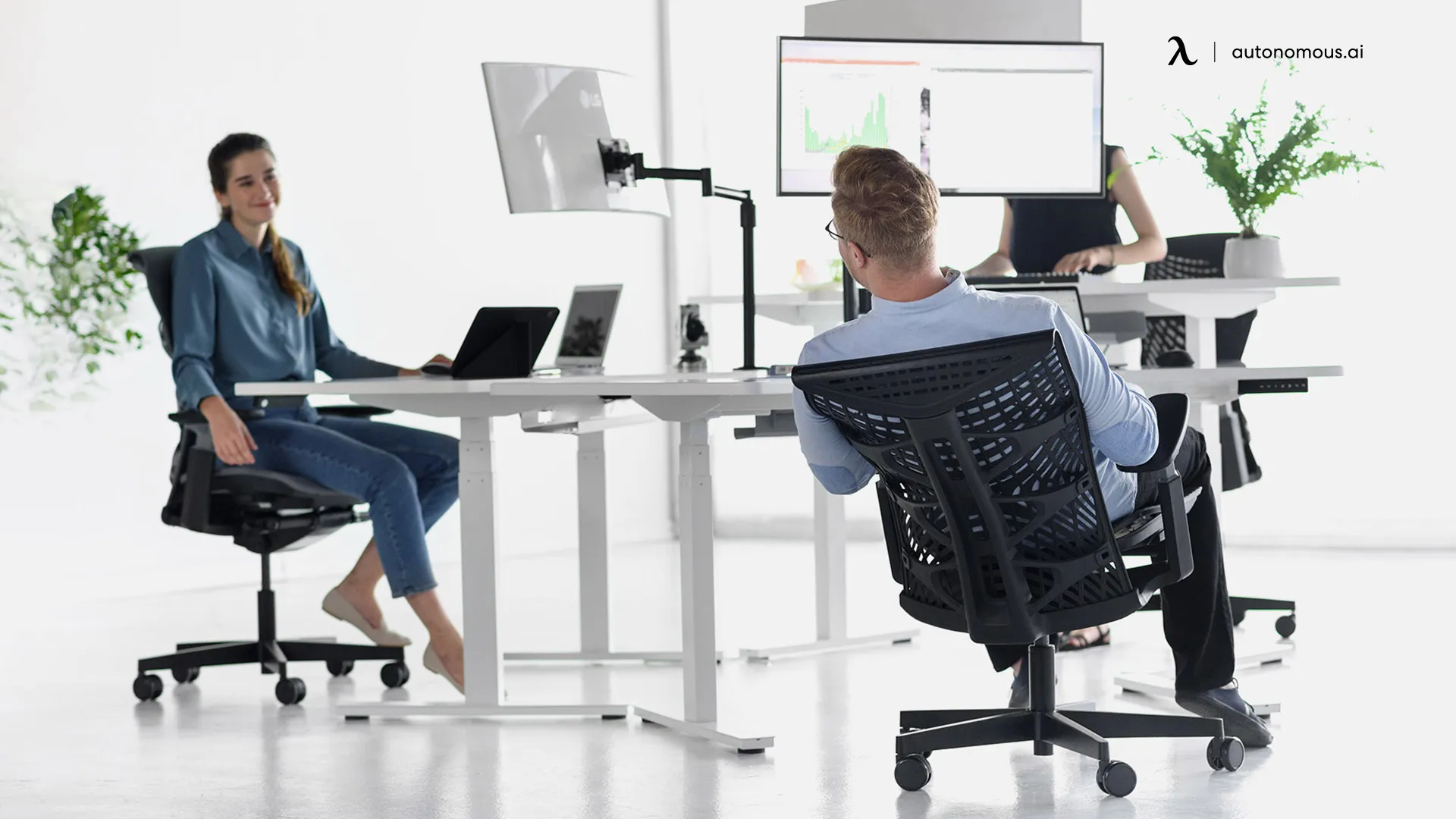
Why Should Companies Understand Office Worker Ergonomics?
Table of Contents
Modern office worker ergonomics has transformed from a mere consideration of comfort to a critical priority for employers. With a growing awareness of how a well designed workspace impacts productivity, employee satisfaction, and overall organizational success, employers are realizing the significance of prioritizing ergonomics. This article examines the various aspects of office worker ergonomics, exploring its effects on employee well being, talent attraction, financial efficiency, and the nurturing of a positive company culture.
Importance of Office Worker Ergonomics Employers Should Know
Effects on Employee Health and Well Being
The way a workspace is designed directly affects the health and well being of its employees. When chairs are poorly designed and desks are not set up properly, workers who sit for long periods can suffer from various health issues such as back pain, neck strain, and repetitive stress injuries. These problems arise when the office workstation ergonomics do not match the natural mechanics of the human body.
Not only does poor ergonomics have physical consequences, but it can also impact mental health. Feeling uncomfortable and experiencing physical strain can increase stress levels and reduce concentration. Given how much time employees spend in their workplace each day, suboptimal ergonomic conditions can affect their quality of life both at work and beyond.

Connection Between Ergonomics and Job Satisfaction
Ergonomics for office workers greatly impact job satisfaction. When employers prioritize the comfort and well being of their employees through ergonomically designed workspaces, higher levels of job satisfaction are more likely to be experienced. This demonstrates care and consideration from the employer, creating a positive relationship between the workforce and the organization.
On the other hand, neglecting ergonomics can lead to dissatisfaction among employees, affecting morale and engagement. Discomfort and physical strain act as persistent barriers that hinder employees from fully investing in their roles.

Statistics on Absenteeism and Healthcare Costs Related to Poor Ergonomics
Poor ergonomics have significant economic consequences, particularly in terms of absenteeism and healthcare costs. Employees who experience musculoskeletal problems are more likely to take sick leave, resulting in higher rates of absenteeism. Furthermore, organizations bear the financial burden of increased healthcare costs due to injuries and illnesses caused by suboptimal ergonomic conditions.
Statistics consistently demonstrate a clear link between workplaces that disregard ergonomic principles and higher healthcare expenses. By understanding the statistical data surrounding absenteeism and healthcare costs, employers can better comprehend the tangible impact of poor ergonomics on the financial profitability of their organization.
The Role of Ergonomics in Employee Retention and Recruitment
When professionals are selecting potential employers, they consider factors that go beyond just job responsibilities. Workplace ergonomics play a crucial role in this decision making process, including features like comfortable seating, adjustable workstations, and a well designed environment. Organizations that prioritize the physical comfort and well being of their employees position themselves as desirable employers in a competitive talent market.
Furthermore, once talented individuals are hired, maintaining ergonomic excellence becomes essential for retaining these valuable assets. Employees who have a supportive and comfortable work environment are more likely to stay engaged, loyal, and committed to the organization over the long term.

What to Do to Improve Office Worker Ergonomics?
Ergonomic Workstation Setup Guidelines
Adjustable Furniture: It is important for companies to offer adjustable desks, standing desks; such as L-shaped standing desks and ergonomic office chairs that can accommodate various body types and preferences. Employees should have the option to personalize their workstations in order to achieve maximum comfort and support. Buy ergonomic wholesale office furniture to reduce the net expenditure.
Monitor Placement: To alleviate strain on the neck, it is recommended to position monitors at eye level. Companies should explore the use of monitor arms to enable flexible adjustments.
Proper Lighting: Creating well lit workspaces is crucial for minimizing eye strain. While natural light is preferred, companies should have adjustable artificial lighting in place to accommodate individual needs.
Keyboard and Mouse Placement: Promoting a neutral wrist position is important to prevent strain injuries. To achieve this, keyboards and mice should be kept at elbow height. Additionally, companies should provide ergonomic keyboards and mice to further reduce the risk of repetitive strain injuries.
Organized Workspace: Maintaining a clutter free and organized workstation is highly encouraged. Utilizing cable management solutions can be beneficial in keeping the environment tidy and free from hazards.
Ergonomic Accessories: To enhance overall comfort and prevent musculoskeletal issues, it is recommended to provide ergonomic office equipment and accessories such as footrests, wrist rests, and mouse pads. These accessories can significantly improve the well being of employees.

Return on Investment (ROI) Considerations for Ergonomic Initiatives
Quantifiable Metrics: Establish measurable metrics to evaluate the impact of ergonomic interventions on employee health, productivity, and satisfaction.
Financial Calculations: Calculate the direct financial benefits, such as decreased absenteeism and increased productivity, in relation to the initial investment in ergonomic improvements.
Employee Retention Data: Analyze employee retention data to determine the success of ergonomic initiatives in fostering a positive work environment that encourages loyalty and dedication.
Comparative Analysis: Conduct a comparative analysis between the costs of implementing ergonomic measures and the potential financial losses that may arise from neglecting workplace ergonomics.
Employee Education and Training
Continuous Learning: Establishing a culture of continuous learning is essential. Offering training programs on ergonomic best practices for employees helps reinforce the importance of ergonomics. Regular updates and refresher courses can introduce new insights or technologies, ensuring that employees remain informed and engaged.
Risk Mitigation: By raising awareness about the importance of proper posture, equipment usage, and workspace arrangement, organizations empower their workforce to proactively reduce the risk of musculoskeletal issues and injuries.
Individual Accountability: When employees have a good understanding of ergonomic principles, they take ownership of their well being. Encouraging individual accountability fosters a sense of responsibility for personal health and creates a culture where employees are invested in the success of ergonomic initiatives.
Productivity Enhancement: Informed employees are more likely to make optimal use of ergonomic features in their workstations. Training sessions can emphasize how proper ergonomic practices contribute to increased comfort, reduced fatigue, and enhanced productivity, reinforcing the positive cycle of well being and performance.

Conclusion
The importance of office worker ergonomics cannot be emphasized enough when striving for a flourishing and prosperous workplace. Employers who prioritize ergonomic considerations enjoy numerous benefits that go beyond physical comfort, including increased productivity, reduced healthcare costs, and the ability to attract and retain top talent. Embracing office worker ergonomics places the well being of the workforce at the forefront and creates environments that promote comfort and efficiency, nurturing loyalty, fostering innovation, and ensuring long term success.
Subscribe for a 10% discount on your first order.
Sign up for our weekly update and be the first to know about our specials & promotions.
Spread the word


/https://storage.googleapis.com/s3-autonomous-upgrade-3/production/ecm/240417/april-10-off-offer-2024-1920x540-CTA.jpg)
/https://storage.googleapis.com/s3-autonomous-upgrade-3/production/ecm/240417/april-10-off-offer-2024-720x1200-CTA.jpg)
/https://storage.googleapis.com/s3-autonomous-upgrade-3/production/ecm/240415/bulk-order-apr-2024-offer-720x1200-CTA-min.jpg)

/https://storage.googleapis.com/s3-autonomous-upgrade-3/production/ecm/230905/Untitleddesign.png)